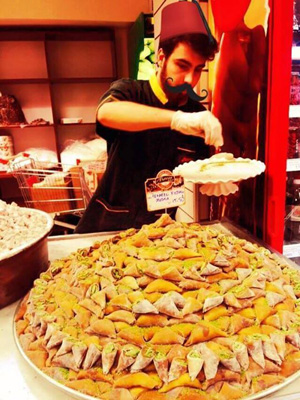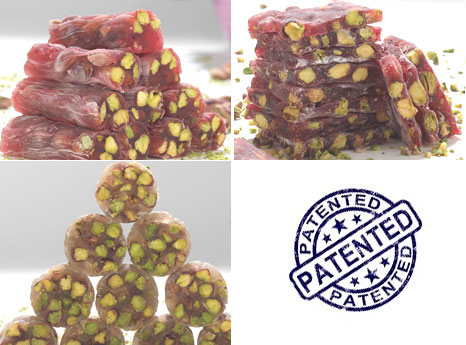 |
 |
|
|
 |
 |
 |
 |
 |
 |
 |
 |
Turkish Delight Manufacturer in
Turkey
 Welcome
to Turkish Delight Factory World! Welcome
to Turkish Delight Factory World!
Private
label turkish delight manufacturing center.
We will help you to find best company which could manufacture
for you at best wholesale prices, and best quality. You will decide
about the manufacturer company. And also we will make you private
packing desing with your logo, your private label.
If you
order one container of our turkish delights we would offer you a
FREE PACKING DESIGN WITH YOUR LOGO.
So contact us, to create your own trade mark turkish
delight.
mail:info@turkishdelightmanufacturer.com
Our
factory started manufacturing in 1960 in Kayseri. Firstly, our
products were sold in historical and tourist places of Istanbul. Our
products are manufactured in clean and hygienic environment. In our
production we are using completely natural and vegetable products .
Our first principle is quality. BRC Standards are applied in our
factory as well. Our goal is to present the best quality of our products
to our customers. We export our turkish delight to 21 countries
including the UK (ENGLAND), Canada, Australia, the USA (America),
South Africa, France, Japon etc.
worldwide wholesale supplier 2tsh2021.
All our
Turkish Delight is gluten and gelatine free. Therefore, our
turkish delight (except honey) is suitable for vegetarians and
vegans.

To see our other Turkish Delights


Our designs of above
Turkish Delights have been patented by
Turkish Patent Institute
To see our patent documents

For more information about turkish delight, please do
not hesitate to contact us.
ADDRESS:
Export Department
Address: Çakmak mah. Bahariye sok. .N0: 36/3 Ümraniye- İstanbul / Turkey
Email: info@turkishdelightmanufacturer.com
Phone: +90 (212) 503 66 00 pbx
WHATSAPP1 :+90.541 375 71 41 (Mr.Ali)
WHATSAPP2: +90. 541 311 21 21(Mr.Yusuf)
Our Factory in KAYSERİ in TURKEY

Our Quality Standards

PHASE OF THE TURKISH
DELIGHT PRODUCTION
Firstly, preparing a syrup with the water easily
for the melting of the sugars before in the
making of the Turkish Delight. After that, the
remainder of the water is mixed with starch in
the separate bowl .This is called ‘’starch mil
mix’’ in practic.The starch milk joins in
boiling At this stage, the acid add to mixture
for the the inversion of the sugar. The best
example of Turkish taste is considered and
accepted all over the world have start
production of delight in cauldron; Cooking
process is materialize maximum 125 ºC and
between in 2-2.5 hour. Used speed mixers
approximately 60-70 per minute during
cooking.These are in the form of a half circle
.The backed delight, after making the required
contributions are dumped into molds.use wooden
and steel moulds at the moulding system of
Turkish Delight According to Turkish delight
varieties and cutting size the format of molds
may change . 2tsh2021.
The dough of turkish delight dump into the pans;
if cutting by hande 5.0 cm or if cutting by
machine 1.5-2.0 apply the height of
casting.After the pouring process,the delight
keep cool for a period of 24 hours in normal
room condidtions.The mass of the indisposed
delight taken from the mold and conveyed to
cutting machine. There are two Turkish Delight
cutting methods, by hand and by machine. There
is powdered sugar or coconut on the bench .
|
|
Turkish Delight Manufacturer in Istanbul (Turkey) © • All
rights reserved.
|
 |
 |
 |
 |
 |
 |
 |
 |
This Turkish Delight recipe is a
traditional version of the classic Middle Eastern sweet. The resulting candy is
delicately chewy and scented with rosewater. Rosewater can be found at Middle
Eastern markets and at some well-stocked supermarkets. There is really no
substitute for this distinctive flavor, but if you cannot find it you can use
another flavored extract like lemon, mint, or any number of floral flavors.
Ingredients: •4 cups granulated sugar •4.5 cups water, divided use •2 tsp lemon
juice •1.25 cups cornstarch •1 tsp cream of tartar •1.5 tbsp rosewater •2-3
drops red food coloring •1 cup powdered sugar Preparation: 1. Prepare a 9x9 pan
by lining it with aluminum foil and spraying the foil with nonstick cooking
spray. Set aside for now. 2. Place the sugar, lemon juice, and 1.5 cups of the
water in a medium saucepan over medium heat. Stir until the sugar dissolves, and
bring the mixture to a boil. Brush down the sides of the pan with a wet pastry
brush to prevent sugar crystals from forming, and insert a candy thermometer. 3.
Allow the sugar mixture to continue boiling, without stirring, until it reaches
240 degrees on the candy thermometer. 4. When the sugar syrup is around 225
degrees, begin to get the rest of the candy ingredients prepared. Place the
remaining 3 cups of water in another, slightly larger, saucepan. Add the
cornstarch and cream of tartar and whisk until the starch dissolves and there
are no lumps. Place the saucepan over medium heat and bring the mixture to a
boil, stirring or whisking constantly. The mixture will become thick and pasty.
5. Once the sugar syrup is at 240 degrees, remove it from the heat. Slowly,
carefully, pour it into the cornstarch mixture, whisking until it is fully
incorporated. 6. Reduce the heat to low and simmer, whisking it every 8-10
minutes, for about an hour, until the candy has turned a light golden-yellow
color and is very thick and gluey. 7. After an hour, remove from the heat and
stir in the food coloring and the rosewater. Pour the candy into the prepared
pan and allow it to set, uncovered, overnight. 8. The next day, remove the candy
from the pan using the foil as handles. Dust your work station with the powdered
sugar, and flip the candy onto the powdered sugar. Remove the foil from the back
and dust the top with the sugar. Use an oiled chef’s knife to cut the Turkish
Delight into small squares. Dust each side of the square with powdered sugar to
prevent stickiness. 9. Turkish Delight is best soon after it is made. It doesn’t
keep very well, but if you want to try keeping it, store it in an airtight
container with waxed paper between the layers, and dust the sides with powdered
sugar again before serving. Making Turkish Delight Introduction: Briefly,
turkish delight is a combination : polymerized cornstarch and carmelized sugar.
Producing either one of those is pretty easy, by itself, but to make turkish
delight you’re producing them together, so that they are mixed into a silky,
sweet, moist but chewy goo. I’d love to find a materials scientist who can tell
me more about what’s going on in this mixture, because it’s clearly some
interesting stuff. But if you’re not into material science, you can just eat it.
When you caramelize sugar, you melt it in water and then drive the water out by
heating it so that the sugar undergoes all kinds of crazy chemical changes that
result in formation of unsaturated polymers. With the corn starch, you’re
melting it in water and heating it so that the molecule chains unravel and form
a mesh that captures water molecules. To make turkish delight you partially
caramelize/polymerize sugar then mix the wet corn starch matrix in, and boil it
down until you drive enough moisture out that the whole mass locks together. The
tricky parts of the process are mostly in keeping it from getting lumpy, keeping
it from turning into a solid block of goo, keeping it from liquifying into a
mass of runny syrup, or making a trip to the emergency room because you burned
yourself with gooey syrup. Sugar syrup and corn starch polymer both hold heat
pretty well – if you get this stuff on your hand it will stick and sit there
while it transfers 200-degree heat to your skin. Avoid that. Things you will
need: An assistant helps a great deal: Ingredients: 4 cups sugar 4 ½ cups water
Juice of one fresh lemon or lime 1 cup cornstarch 1 teaspoon cream of tartar up
to 2 tablespoons flavoring (more on this later) Tools: 2 saucepans wooden spoon
measuring cups measuring spoons heat resistant spatula 9x9" silicone baking
pan(s) candy thermometer (don’t even try to make this recipe without one!)
Making this recipe will consume between 1 and 1 ½ hours. This is all the stuff
laid out ready to go. The first time I make anything, I always lay everything
out so I don’t have to fumble around as I try to find it. Greasing the Pans
Don’t try to make this without silicone baking pans. I have personally thrown
away 4 batches of turkish delight that stuck to my pans; it’s like gooey epoxy.
The only thing I have found it won’t stick to is lightly oiled silicone baking
pans. It’ll even stick to dry silicone! It’ll stick to wax paper! It’ll stick to
parchment paper! I use square baking pans that are 9"x9" . Wipe them with a very
very light coat of vegetable oil. All you’re trying to do is fill the
microscopic pores in the silicone, you hardly need any oil at all. But you sure
do need a bit. Put the pans on the stove out of the way but in reach. When
you’re ready to pour your goop out it’ll be hot and you won’t want to carry it
around the kitchen. Make sure the pans are on a flat surface or you’ll get
uneven-shaped turkish delight. In this example we are going to make a 2-flavored
batch. Normally, I make just one flavor and it’s a lot easier. But it’s nice to
have lemon/clove and rose/pomegranate or something like that – different flavors
make your end product more interesting. Pans on stove with silicone pans and
little bowls with flavoring mixes. Since we are making a 2-flavor batch, I have
one flavoring mix near each of the silicone pans, to keep things organized.
Flavorings: Either: 1 tablespoon rose water 1 tablespoon pomegranate juice
(mostly for coloring), can use grenadine Or: 1 tablespoon lemon extract 1
tablespoon clove-water tea (take a dozen cloves and boil them in ½ cup of water
until there is 1 tablespoon of liquid left. Drain. Use.) Or: 1 tablespoon mango
extract 1 tablespoon lavender tea (take some lavendar blossoms and boil them in
½ cup of water until there is 1 tablespoon of liquid left) Obviously, you can
have fun with your flavorings. I’ve found that more than 2 tablespoons of water
is a bad idea – you’re mixing it into the caramel/goo at the end and if you add
too much water it’ll separate out and you’ll have sticky goo instead of turkish
delight. If you’re making a 2-flavor batch, halve the quantities of flavorings
that you’ll put in each half-batch. I don’t think that oil-based flavorings work
as well as sugary/extract/watery ones. I’ve used pure clove oil and it tended to
promote clumps. Instead I prefer to make flavored tea(s) by just boiling herbs
or spices in the microwave in a small bowl and draining off the results. You can
buy flavoring extracts on amazon.com – make sure you get food flavor not massage
oil. There are lots of products that contain "rose petal" and you want the food
flavoring not the skin cream. Trust me. Sugary Syrup: Juice the lemon, then mix
the lemon, the 4 cups of sugar, and 1 ½ cups of water in a saucepan. Turn on the
heat and put the candy thermometer in. Stir it occasionally as it comes to a
boil. Keep stirring and watch the temperature; when it reaches 230F (soft ball)
you’ll be ready to go to the next step. (Syrup in pan coming to heat while
cornstarch mixture sits) While the sugar is boiling on its way to 230 degrees F,
put the 1 cup of cornstarch and 3 cups of water in the other saucepan. Add the
cream of tartar. Stir it gently. Initially, when mixed, the cornstarch will
clump up into a weird goo. Be gentle when you stir it; cornstarch in water is a
non-newtonian fluid and resists being stirred proportionally to how hard you
stir it. It’ll take a bit of gentle work but you can turn the cornstarch/water
mixture into an evenly-mixed milky liquid. There should be no clumps in it.
Caramel and Cornstarch This is the trickiest part of the whole process. Once the
sugar hits 230 degrees F, turn it off, and turn your attention to the corn
starch/water mix. Turn on medium heat and stir it constantly while you bring it
up to a simmer. When the cornstarch starts to boil it will very quickly convert
into a thick paste. You need to catch it right before it does that; pay
attention to nothing else and stir the cornstarch while it heats. As soon as you
feel it starting to get a bit sticky/thick on the bottom of the pan, lift up
your spatula or spoon and if there’s goopy-looking gluey stuff on the bottom,
you’re just about ready to take it off the heat. I usually turn the heat off and
stir a bit more and suddenly it’ll begin to thicken into a creamy glue. Do not
let it overdevelop – as soon as it turns creamy, pour it into the sugar syrup
and stir it in. If it turns into hard rubbery stuff your best bet is to dump it
and make another batch of cornstarch really quickly. (Creamy-looking cornstarch;
the stuff keeps thickening as you scoop it out of the pan) The cornstarch/syrup
mix will initially be a bit white but as you blend them it should turn clear.
Put the heat on and start to bring it back to a boil. Stir constantly and squish
any blobs of cornstarch to get them completely mixed with the sugar syrup. If
the cornstarch is too tough to mix in, you let it go too far and your turkish
delight will be granular and have hard plastic-tasting bits in it. (mixing the
syrup and cornstarch over heat) Boiling Down the Turkish Delight Once the
cornstarch/syrup mix have started to boil, keep stirring them. You’ll need to
use a spatula periodically to keep it from collecting and hardening on the edge
of the pan. (Stir periodically) After a while the syrup/goo will start to clear
and get gooeyer. If you stir it vigorously, it may separate from the edge of the
pan. You’re going to stir the goo for about 40 minutes more or less, and the goo
will begin to get slightly yellowish and thicker. You can test how thick it’s
getting by taking the spoon out and letting it cool a bit – it should solidify
and get gooey. (Testing!!) (turning yellow) Finishing If you’re making a
single-flavor batch, simply turn off the heat, stir in the flavor ingredient
thoroughly, and pour it in the silicone pan. You’re done! If you’re making a
two-flavor batch, take another saucepan (or the cornstarch pan, rinsed) and put
it on medium heat so the pan will get warm. If you pour the hot goop into a cold
pan it’ll congeal! Pour half of the mix into the pre-warmed pan, then add the
flavoring and stir thoroughly. Pour off into the pans. (mixing the pomegranate
flavor in ½ of the goop) Let the goo cool overnight. Do not cover. If you’re a
perfectionist (like I am!) you can dust the top of the pan-fuls of goo with
powder mix while it’s still damp – that way it’ll stick. See the next step...
Cutting and Powdering To finish the turkish delight the next day, you’re going
to cut it up and put it in powdered sugar and cornstarch. Take cornstarch (about
1 cup) and confectioner’s powdered sugar (about 1 cup) and mix them together in
a container. You’re going to use this powder to keep the turkish delight from
sticking to itself, the floor, your clothes, etc. Make a flat surface of powder
on a cutting board, then pull the goop out of the silicone tray and put it down
on the powder. Flip it over as necessary and get both sides covered so they
aren’t sticky. Get a flat-bladed knife like a cleaver or the insanely expensive
sushi knife shown above, and powder its edges, then quickly press it through the
turkish delight to cut it into strips. Cut fast with a pressure downward; don’t
try to draw-cut or it’ll curl and stick to itself. Put the cut strips into the
powder container so that the exposed fresh edges get powdered. Then line them up
on the cutting board again and cross-cut them. A small strainer is a good way to
distribute powder without rubbing it; simply put some in the strainer and shake
it gently over the turkish delight. Then you’re done! Storage and Packaging Do
not ever put turkish delight in an airtight container. It’ll release moisture
and get sticky. My favorite way of storing it is in a little paper bag that I
can shake periodically. You can box it as long as you don’t use an airtight box.
This little box of turkish delight was filled with several layers, separated
with sheets of parchment paper and powder. It was then wrapped and sealed with
wax pressed with the butt end of a live .50 BMG SLAP round. Don’t put live
rounds into 400 degree wax!I survived but you might not! the ENGLAND UK,
Australia,Albania, Bahamas, Algeria, Andorra, Angola, Antigua, Barbuda, Argentina, Armenia, Australia, Canada Austria, Azerbaijan, Barbados, Botswana, Czech Republic, Cyprus,,Ethiopia, Georgia Great Britain, Hungary,Greece France Guinea Guatemala Finland Egypt Ecuador El Salvador Estonia Eritrea Honduras Equatorial Guinea Ghana Grenada Germany England Haiti Iceland India Kosovo Libya Lithuania Kazakhstan Jordan Israel Lesotho Kiribati,Kyrgyzstan Liechtenstein Lebanon Kuwait Korea, South Kenya Korea, North Iraq Latvia Liberia Iran Jamaica Italy Ireland Indonesia Laos Malta The Netherlands Brunei, Darussalam, Bulgaria, Cameroon, Cambodia, Afghanistan ,China, Colombia, Denmark, Dominica,Burkina, Faso Burma, Benin, Cuba Costa Rica, Comoros, Burundi, Bhutan, Belgium, Bangladesh, Belize, Belarus,Bahrain, Bosnia & Herzegovina, Bolivia, Central African, Republic Chile, Cape Verde, Croatia,Mauritania Moldova Malaysia Malawi Nepal Mauritius Marshall Islands Madagascar,Madagascar Madagascar Luxembourg Mozambique Mexico Nicaragua Oman Palestinian State* Pakistan Qatar Romania Russia,Saudi Arabia Senegal Papua New Guinea Panama Portugal Poland Slovakia Serbia South Africa Somalia Slovenia The Philippines Maldives Macedonia Norway New Zealand Niger Northern Ireland Montenegro Uganda United Kingdom Uzbekistan Uruguay Tajikistan South Sudan Togo Tanzania Sweden Sri Lanka,Sudan United Arab Emirates Trinidad & Tobago Ukraine Syria Yemen Zambia Venezuela Zaire Zimbabwe. Micronesia Monaco Mongolia Morocco Nigeria Namibia Spain Turkmenistan Tunisia to the all over the world.France, Japon USA Amerika, South Africaetc.




















 Welcome
to Turkish Delight Factory World!
Welcome
to Turkish Delight Factory World!





